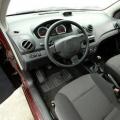It is very important not only to be able to drive a car well, but also to know what the car consists of, how to monitor it and properly maintain it. In this article, we will consider an urgent question for a battery: what should be the electrolyte level in a car battery, and what does it affect?
Electrolyte and its role in the battery
So, let's start by defining what is still called an electrolyte. It is simply a solution of sulfuric acid and distilled water. Moreover, the presence of some foreign impurities is unacceptable, because then its density will change, which will have a most negative effect on work battery... Its level also plays a very important role. So, for example, if it is below normal, the inner plates will dry out and the power will decrease.
Do not think that the solution will be to top up the liquid in excess of the norm, because in this case the acid will corrode the outer part of the unit. In addition, you may encounter such problems as fast self-discharge of the battery or failure of the voltage regulator. In general, the correct electrolyte level is the key to the proper functioning of your car, so you should periodically inspect the battery.
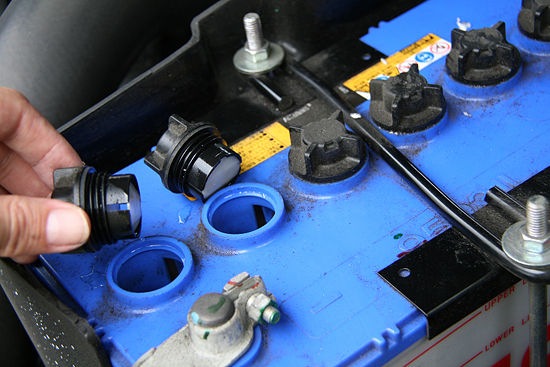
How to check the electrolyte level in the battery?
It is believed that rechargeable batteries do not need maintenance, and, in principle, this is the case, but please note - this is about normal operating conditions. Those who like to travel on their "iron horse" or residents of regions in which a very hot summer reigns should still control the above parameter. Indeed, the electrolyte contains water, and it is known to evaporate.
In addition, malfunctions of the relay-regulator contribute to intensive boil-off. The following signs indicate that it is time to check the condition of the battery:
- from the filler holes soars strongly;
- you can see drops of electrolyte on the battery case;
- the battery itself gets very hot.

The electrolyte level in the battery is checked different ways... The most simple is visual control... Typically, the battery case containing the liquid is made transparent and marked with maximum and minimum level marks. And, accordingly, the amount of electrolyte should be within these limits.

The electrolyte level decreases due to the evaporation of water or the leakage of the composition due to damage to the case. In the first case, you can independently correct the condition of the battery.
But sometimes there is no such possibility, then it is necessary to act something like this. We take a transparent tube with a diameter of 5 millimeters and lower it into the tank until it stops. Then tightly pinch the outer hole of the tube with your finger and pull it out. It will contain the liquid to be measured. The electrolyte level will correspond to the height of its column in this tube.
Low electrolyte level in the battery - what should the car owner do?
So, the height of the liquid in the tube should be within 10-15 millimeters. If it is more than the norm, then the excess should be removed. This is quite simple to do, you just need a rubber bulb or syringe, with which you can pump out the excess in a matter of seconds. Naturally, after this operation, we check again. But if the analysis showed a low electrolyte level, what to do then?
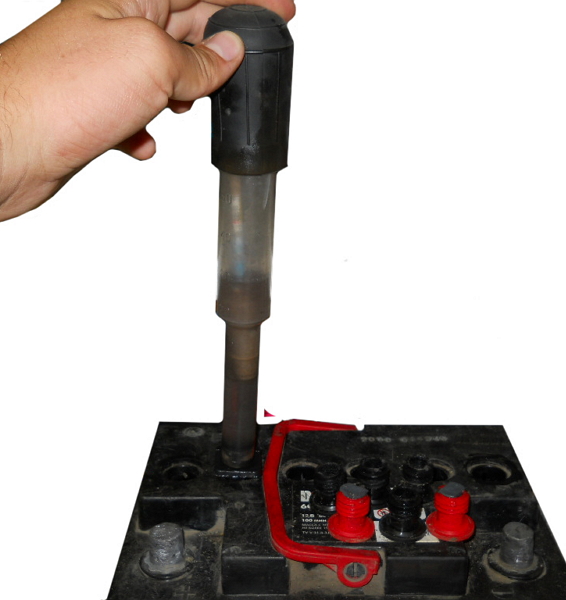
Before talking about the amount of electrolyte in the battery, I highly recommend the article, from what. Today's information will be useful to almost everyone, especially those who are restoring batteries, say after closing a bank, and do not know how much to buy, because the old one has been drained and is no longer really suitable for use. It often happens - this liquid simply evaporates, generally to zero, of course in car batteries I rarely saw this, however, for example, in installations uninterruptible power supply servers - computers, can happen quite often ...
Earlier, during the Soviet era, the electrolyte was sold separately. That is, there were so-called "dry" batteries, into which you yourself had to pour this liquid and charge it correctly. However, now technologies and production are moving forward, the factories are fully flooded and charged, then they are allowed to go into mass consumption. Now the batteries are sealed and non-separable!
How much electrolyte is sold?
Now it's not such a big problem to buy this liquid, you just need to sit down and go to a specialized store where batteries are sold, it is unlikely that it will be in ordinary spare parts.
Basically, it is sold in only two containers, these are 1 liter (bottle) and 5 liters (canister). If you have repaired, say - you need to fill in only one can, then 1 liter will be enough for you, which is said “for the eyes”. The cost ranges from 50 rubles per liter bottle and up to 200 - for five liters.
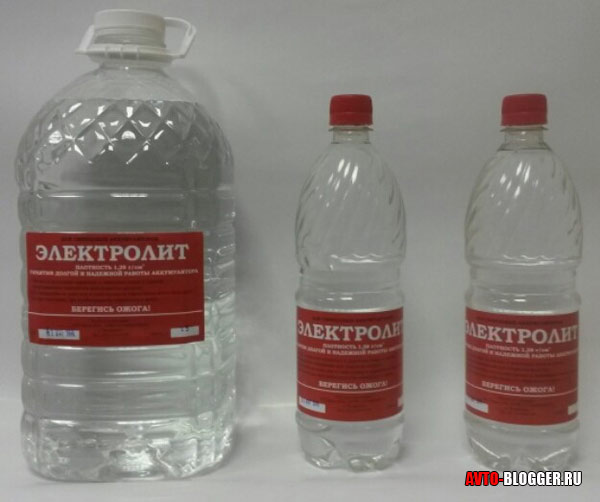
But if for some reason you need to change the entire volume, then it all depends on the size of your battery and its power.
Dependence of volume and current
It is clear that the volume of 45Am / h will be much less than that of the 190Am / h version. If you dig into physics, for a powerful battery you need more lead (which will fit in a more bulky case), which is why the dimensions of the 190 version will be almost 4 - 5 times larger than, say, the 45 - ki. And where there is more of this metal, there is also a need for more electrolyte in order to effectively accumulate voltage.
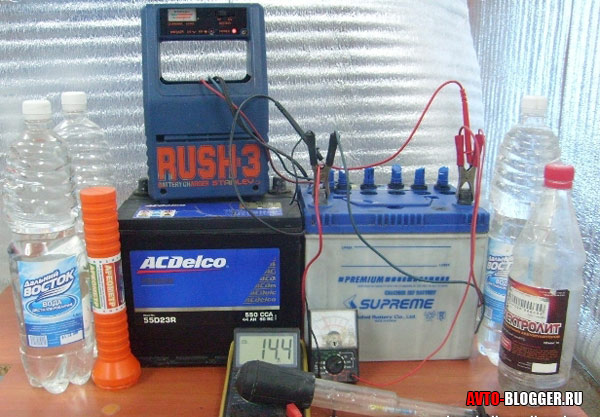
However, if you think about the question - how much you need to buy in order to guess for all the options (take, as it were, with a margin), the answer suggests itself. After all, the maximum canister, which is sold in only five liters, is accordingly suitable for almost all models. In order not to be unfounded, I want to disassemble the most popular "Amperage".
I'll make a reservation right away, there are slight differences depending on manufacturers, but they fluctuate in insignificant grams.
55 Amperes - hour
The weight of such models is about 15 kilograms (more about). The volume of electrolyte, this battery, under full gas station equals 2.5 liters, plus or minus 100 grams. I repeat once again, this is if we take a completely dry case and fill in the required displacement.
60 Amperes - hour
Here, the total weight increases by 2 kilograms, pure lead by 400 grams, plus about 1300 grams in the compounds. The rest is filled with electrolyte, here it is about 2.7 - 3.0 liters.
75 Amperes - hour
Here, the mass increases by another 4 kg, mainly lead and compounds, but the electrolyte is 3.7 - 4.0 liters.
90 Amperes - hour
The liquids in it are about 4.4 - 4.8 liters.
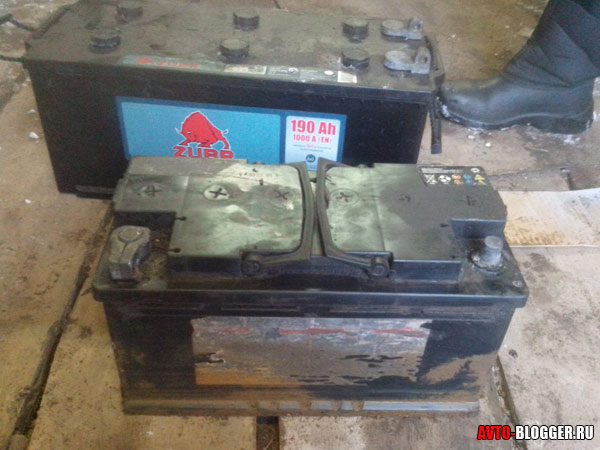
190 Ampere-hour
This is the most powerful and largest battery, it is installed on trucks and often on special equipment. Here, the displacement can exceed 10 liters. Often just two 5 liter cans. each, leave before full refueling.
What level should be?
If we talk about the "correct" filling of the cans, then do not pour to the eyeballs! This is not correct, when charging, the electrolyte can expand, and if it is filled to the top, it will simply pour out, which is not good! Usually inside there are certain marks, or "tongues" by which you need to navigate. They should be slightly hidden. Watch a detailed video.
If evaporated what to do?
Many people mistakenly believe that if the electrolyte level has dropped (due to evaporation), then you need to buy a little more and add to the level. Guys, this is not entirely correct.
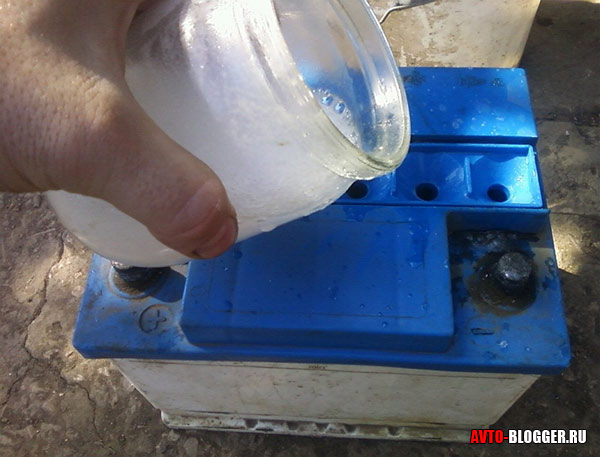
This liquid consists of acid and water, it is the water that evaporates and therefore the level drops, but the sulfuric acid remains, it seems to increase in concentration. In order to return the desired level, you need to add only, but in no case - not electrolyte! If you add it, you will increase the acid concentration, which can damage your battery.
Take good care of it and it will serve you for a very long time. This concludes your AUTOBLOGGER.
Hello dear motorists and blog site readers.
Today I will continue the story I started about and extend its service life.
What to do if the electrolyte level is below normal?
If the electrolyte level is below normal, but approximately the same in all sections, it means that water has evaporated from the electrolyte. But there is no need to rush to top up the water. Make sure there are no signs of leakage to avoid corrosion of the battery attachment point. If everything is in order, add distilled water to the battery. After adding water, do not worry about a decrease in density - the density will temporarily decrease due to the fact that the water and electrolyte have not yet had time to mix sufficiently. Complete mixing will take place within a few weeks.
If the electrolyte level is below normal, and it is different in the sections, this may be due to a leak or a section defect (leakage due to a defect in the separators).
Topping up with distilled water is not difficult. It is advisable to do this using aerometer.
But adding electrolyte requires some knowledge.
Firstly, it is necessary to add electrolyte only in the event of a leak and not otherwise. You need to add electrolyte only of the density that exists directly in this section. It is important to remember that the temperature of the electrolyte to be added must correspond to the electrolyte to be added in this section. The plates should never be allowed to "float". Of course, the plates do not float anywhere, this decreases the electrolyte level. This can lead to a short circuit between the plates and, as a result, an explosion of the battery.
The batteries indicate the level to which the electrolyte must be topped up. But if this feature is not present, then the electrolyte level should be higher than the plates by 15-20 mm.
After bringing the electrolyte level to normal, wipe the battery with a soft cloth. In general, it is recommended to add only distilled water!
For a long battery life, do not forget the following rules:
You can turn on the starter for no more than 3-5 seconds, and the breaks between starts should be no less than 10-15 seconds.
When stopped, do not turn on many consumers.
Remember that discharging the battery by more than 25% of its capacity can lead to the impossibility of starting the engine (in winter, the resistance of a cold engine increases three times), or to freezing of the electrolyte. When the battery is discharged, the density of the electrolyte decreases. As a result, it can freeze. The more the battery is discharged, the electrolyte freezes at a higher temperature. For example, with an electrolyte density of 1.11 g / cm3, it will freeze at a temperature of -7 ° C, and at a density of 1.27 g / cm3 only at -58 ° C.
If your battery has frozen electrolyte, then it is possible to restore the battery operation. Of course, it all depends on the degree of freezing of the electrolyte. If the battery is not completely frozen and deformed, it can be restored. To do this, the ice must be melted at room temperature, and then the battery must be charged.
Factors affecting battery life:
- The intensity of battery operation;
- Serviceability of electrical equipment;
- Regularity of checking the density and level of electrolyte;
- The temperature at which the battery is operated;
When using the battery, you must follow the safety rules:
1.It is impossible to short-circuit the hatcher.
2.Do not under any circumstances seal the accumulator, and the gas outlets must not be clogged.
3. The battery must not be overheated. +55 is the maximum temperature for its operation.
4. Do not allow self-loosening of plugs and battery fastening.
5. Do not subject the battery to mechanical stress.
6. Do not remove the terminals while the engine is running.
7. Do not use naked flames near the battery.
Remember that the storage life of the battery without recharging depends on the type of battery.
Battery types
1. Low antimony (Sb / Sb) - from 3 to 5 months
2. Hybrid (Ca / Sb) - from 5 to 8 months
3. Calcium (Ca / Ca) - from 8 to 12 months
Follow the simple recommendations given in the article, and your battery will serve you reliably and for a long time.
Until next time!
It depends on the state of the battery whether you can start the engine of your car or not. By reading this article, you will learn what affects electrolyte levels and how to identify and regulate them. You will learn how the electrolyte level affects the state of the battery and why a drop in the level decreases not only the capacity, but also the battery life.
What affects electrolyte levels

To answer this question, you need to understand what happens inside the battery during charging and discharging. When serving charging current Lead dioxide at the cathode (negative contact) gives up not only free electrons, but also oxygen molecules, turning into lead. On the contrary, at the anode (positive electrode), lead absorbs electrons and oxygen molecules from the electrolyte, turning into lead dioxide. In both processes, free hydrogen and a small amount of oxygen are released from the electrolyte, which are released into the atmosphere. The stronger the charging or discharging current, the more hydrogen and oxygen is released into the atmosphere. In addition, a strong charging or discharge current leads to the boiling of the electrolyte, as a result of which not only pure hydrogen and oxygen, but also water vapor, escapes into the atmosphere. All this leads to a drop in electrolyte levels over time. This process takes place in any battery.
Why is the level going down
If the electrolyte level drops enough to expose the lead plates, the battery life is drastically reduced. This is because oxygen gas from the atmosphere interferes in the oxidation and reduction reaction. As a result, the balance of pure lead and its dioxide changes, and with it the capacity and operating voltage of the battery drop. The addition of distilled water allows, but cannot restore their condition. Another reason why electrolyte levels may drop is mechanical damage housing. Even a small crack, which is very difficult to see with the naked eye, can cause electrolyte loss. With a leak of 1 drop per hour, the battery will lose 30-50 milliliters of electrolyte in a month. Approximately 0.5 liters throughout the year, that is, almost all the electrolyte of one battery can.

How to check and restore electrolyte levels
To check the electrolyte, you will need:
- a clean rag to remove dirt from its surface;
- a wide (at least 1 cm) flat screwdriver, with which you will unscrew the filler plugs;
- lantern.
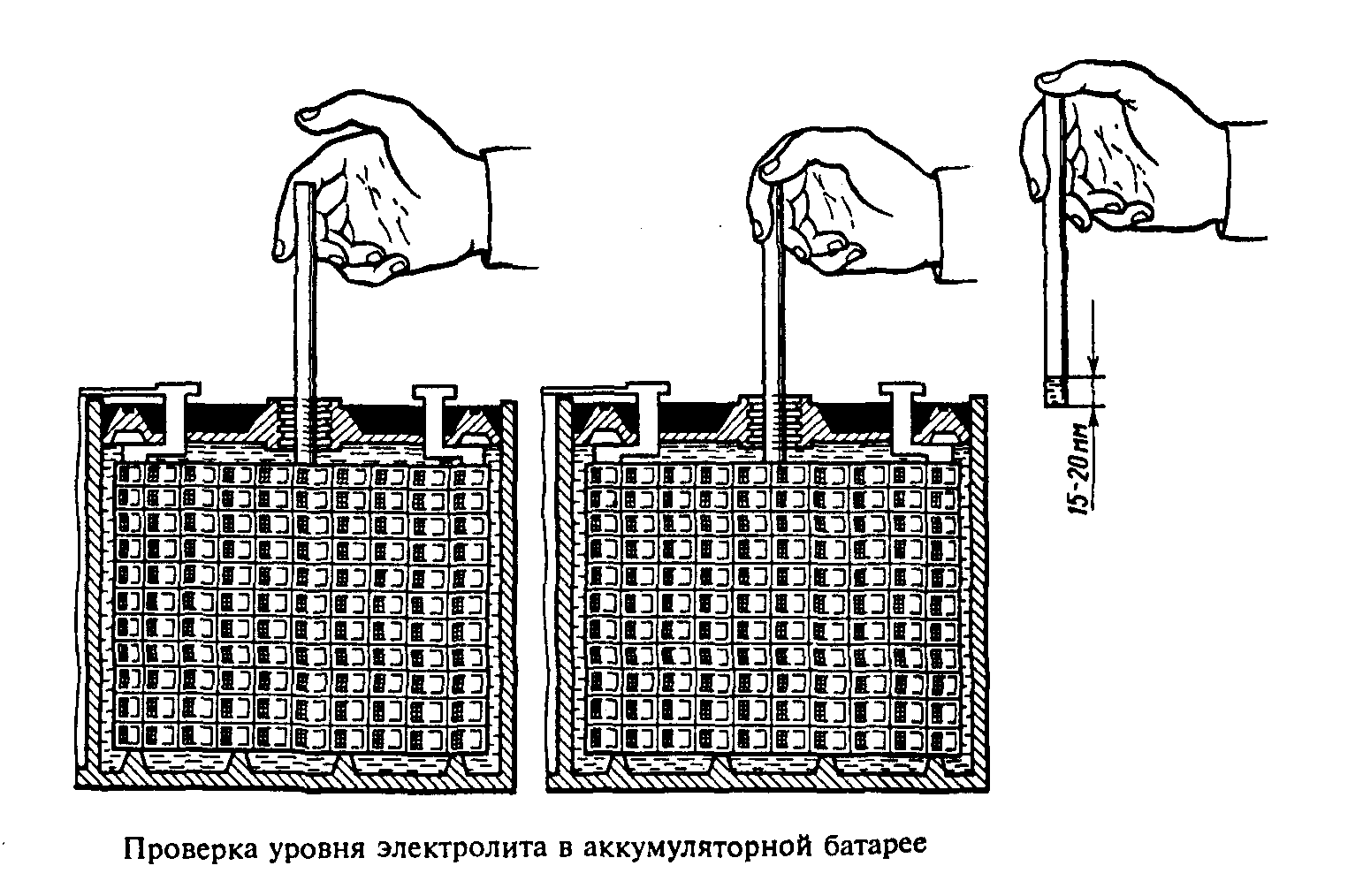
Open the hood and inspect the battery. On some vehicles, the battery must be removed to check and add electrolyte. If nothing prevents you from unscrewing the plugs and using a flashlight, then use a rag to clean the battery from dust, dirt and liquid droplets. Its surface must be dry and clean. If the filler caps are covered with a plastic cover, remove it. Then unscrew all plugs and set them aside. The electrolyte level should be 1.5-2 cm below the surface of the battery. For a more accurate level check, a glass or plastic rod is required. Insert it into the filler hole and bring it to the upper edge of the plates. The electrolyte level should exceed the plates by 1.5-2 cm. If the level is lower and you cannot see the electrolyte, shine a flashlight into the filler hole. If the plates are visible, then the battery life has already suffered. If you restore the level and density of the electrolyte, then it will give normal current, but the capacity will decrease.
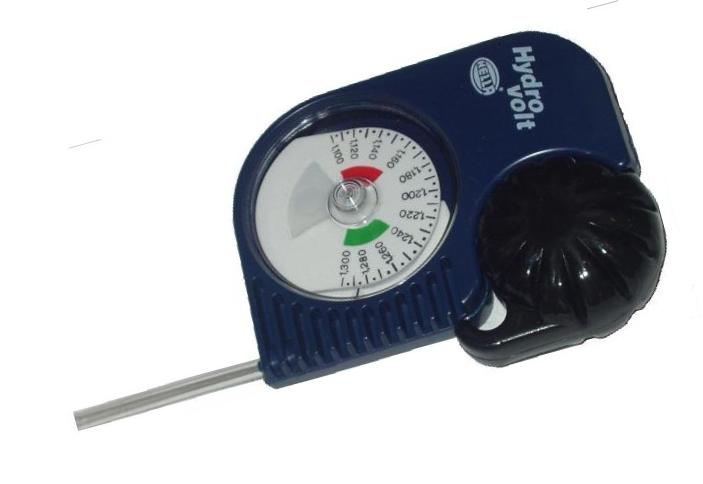
If the electrolyte level is less than it should be, check it with a hydrometer, which you can buy at any auto store. If the electrolyte density of a discharged battery is below 1.2 g / cm³, and a fully charged battery is below 1.29 g / cm³, the problem is in the battery case. The evaporation of oxygen and hydrogen reduces the volume, but increases the density of the electrolyte above standard. Leakage not only reduces volume, but also. A battery that loses electrolyte is useless to repair, in most cases the crack is invisible. Otherwise there would be a wet spot around the battery.
After making sure that the problem is not an electrolyte leak, proceed to restore its level. To do this, use only distilled water. It is advisable to pour it with a watering can. This will prevent water from spilling over the surface of the battery and the ingress of various pollutants into the cans, which will become participants in chemical reactions. Pour water in a thin stream to avoid exceeding the level. Having raised the electrolyte level, clean the hole (breather) of the plug and screw it into the battery. Do this with each battery bank.
The caps that each battery bank is equipped with should not be unscrewed with an ordinary screwdriver - you can damage the plug. An ordinary coin is suitable in this situation. Diagnostics consists of several points:
- Electrolyte density check
- Checking the electrolyte level in the battery
- Battery charge measurement without load and with load
Usually the battery is provided with a minimum and maximum mark on the case. But if they are not there, then the measurement is made using a glass tube of the appropriate diameter.
The order of making measurements is as follows:
- Unscrew the battery cap
- Taking a glass tube, lower it into the battery
- Plug the tube tightly with your finger and pull out
- Measure the length of the electrolyte column in the tube
The normal electrolyte level in a battery is between 12 and 15 mm. The battery plates must be covered with exactly this electrolyte level. Battery operation with electrolyte level below 12 mm is not allowed. Low level electrolyte leads to oxidation and destruction of the battery plates. Also, exceeding the maximum level is not permissible.

The electrolyte level decreases as the water boils off. That is, to restore the previous value, you should top up with distilled water. Water is poured into the filler neck to the lower end of its tube. After refilling, the battery must be charged. In a charged battery, the density of the electrolyte is checked, normally it is 1.27-1.29 g / cm 3. An instrument called a hydrometer is used to check the density of the electrolyte. If you have topped up liquid into the battery, do not measure the density right away, the water will take 3-4 hours to mix with the electrolyte. And when carrying out any measurements, it is important to be careful, because sulfuric acid is used as an electrolyte in the battery.
Here the norm is given when the performance of the battery is especially important. When the density is above the specified level, the electrolyte is diluted with water. If the density is low, electrolyte is topped up.
It is also possible to measure. This requires a device called a voltmeter. The battery must be disconnected from on-board network... And if the car has just been in operation, it is better to postpone measurements for an hour. Measurements should be taken in a warm room. The charge level should be approximately 12.5 volts for a fully charged battery. A special load plug is used to check charge with load.
Battery density measurement:
Pay attention to the color of the electrolyte. Normally, it should be transparent. Reddish or dark color signals the destruction of the plates. Such a device should be disposed of as soon as possible; it cannot be repaired or restored.
Now, having learned the answers to a number of important questions regarding the operation of the battery, namely, what the electrolyte level, charge level and electrolyte density of the battery should be, the driver can avoid a number of problems. Timely diagnostics, identification and elimination of battery malfunctions allow extending its service life, as well as not being in an unexpected unpleasant situation.
If, and after being diagnosed, malfunctions are identified and eliminated, the car has difficulty starting, the starter and the car's wiring should be checked for a malfunction.
- news
- Workshop
Swiss motorcyclist has traveled around the world in 119 days
It should be noted right away that Sanders' time did not take into account those pauses when the motorcycle had to be transported between continents. While Urs Pedrighta included these "delays" in his timer. The Ursa Pedrighta Moto Marathon began on March 12 in Daytona Beach, Florida, from where he immediately raced southwest to travel to South America. ...
AvtoVAZ will release a special version Lada Vesta for 760,000 rubles
AvtoVAZ presented special limited sedan Vesta and crossover XRAY, which are dedicated to the 50th anniversary of the car plant. As a basis for the special versions, richly equipped versions of the cars were taken, which in addition received a red and black interior trim, special wheel disks and additional logo. It is noted that the cars of the anniversary series will be released in a limited edition ...
Medvedev urge to give a hand for too expensive gasoline
Let's remind: over the past week, the cost of motor fuel in Russia increased again. So, according to the information and analytical center "Cortes", average cost liter of AI-92 increased by 9 kopecks, and since the beginning of 2016, the "ninety-second" has risen in price by 91 kopecks (+ 2.7%). Moreover, in the country, "fuel" is getting more expensive differently - in some regions prices are growing, ...
Where do they buy Lada XRAY: regions named
In total, by the end of February 2016, 44 such cars were sold in this republic. This is evidenced by the study russian marketconducted by the analytical agency "Autostat". In second place in terms of prevalence of "X-Reev" was St. Petersburg. In the northern capital, 43 crossovers were sold in February. The third place went to the Samara region, where ...
Tesla will release a very affordable electric car
On plans to release a new electric car, which may be called Tesla Model 4, at the Transport Solutions conference in Norway, the head Tesla Motors Elon Musk reports Auto Express. Musk said he was "extremely happy" to release the Model 3, a car "most can afford." However, at the same time ...
The cost of gasoline in Russia has ceased to depend on oil prices
According to the portal Clever-tanken.de, the cost of a liter of fuel at filling stations in Germany over the past week has decreased by an average of one cent. So, for a liter of 95th gasoline in Germany, on average, they ask for 1.29 euros, and for a liter of diesel - 1.09 euros. If you look at absolute numbers, then automobile fuel in Europe is much more expensive than Russian fuel. So, ...
Cadillac will make an SUV for $ 250,000
The American company plans to release two ultra-luxurious novelties at once - an SUV and a sedan, each of which will cost from $ 250,000 to $ 300,000, which will appear before 2030. About this with reference to sources within the company reports the portal GM Inside News. Premium SUV Cadillac should hit the market around 2027 ...
Chevrolet niva increased in price, but became safer
From July 1, for the "top" trim levels GL, GLC and LE +, the existing safety package will be supplemented by a three-point seat belt for the middle passenger in the rear row, an improved ISOFIX system and a driver's seat belt not fastened warning lamp. According to the press service of GM-AvtoVAZ, the design of the backs and mounting brackets of the rear ...
Slow driving in the left lane was more dangerous than speeding
As it turned out, the reason for this lies not at all in the speed of movement. It is much more important that drivers use the left lane only for overtaking, and after completing it, return to the right lane. As the journalists explain, prolonged driving in the left lane with an average flow rate or lower is much more dangerous than non-compliance speed mode... Cause...
Russian car market: minus againMoreover, the fall is sometimes measured in double digits. For example, in August it was minus 18%, and in July - minus 16%. Against this background, the September indicators are perceived almost as a success - “only” minus 10.9%. However, recall that this is minus eight compared to September 2015, which amazed everyone ...
HOW to choose a car for rent, choose a car for rent.
HOW to choose a car for rent, choose a car for rent.
How to choose a car rental Car rental is a very popular service. It is often needed by people who have come to another city on business without personal car; those who want to make a good impression with an expensive car, etc. And, of course, a rare wedding ...
HOW to choose and buy a car, Buying and selling.HOW to choose and buy a car, Buying and selling.
How to choose and buy a car The choice of cars, both new and used, on the market is huge. And not to get lost in this abundance will help common sense and a practical approach to choosing a car. Do not give in to the first desire to buy the car you like, carefully study everything ...
Four sedan test: Skoda Octavia, Opel astra, Peugeot 408 and Kia ceratoTest of four sedans: Skoda Octavia, Opel Astra, Peugeot 408 and Kia Cerato
Before the test, we can safely say that it will be "Three against one": 3 sedans and 1 liftback; 3 supercharged motors and 1 aspirated. Three cars with a gun and only one with mechanics. Three cars are brands in Europe, and one is ...
Pickup review - three "bison": Ford Ranger, Volkswagen Amarok and Nissan NavaraPickup review - three "bison": Ford Ranger, Volkswagen Amarok and Nissan Navara
What people can't think of to feel an unforgettable moment of excitement from driving their car. Today we will introduce you to a test drive of pickups not in a simple way, but by connecting it with aeronautics. Our goal was to examine the characteristics of such models as Ford ranger, ...
The most expensive cars in the worldThe most expensive cars in the world
Of course, any person at least once wondered what kind of expensive car in the world. And without even receiving an answer, I could only imagine what the most expensive car in the world is. Perhaps some people think it is powerful, ...
Some 2-3 years ago it was considered a priori that available car must be mechanical box gear. Five-speed mechanics were considered their lot. However, now everything has changed dramatically. First, they installed the machine gun on Logan, a little later - on the Ukrainian Chance, and ...
HOW to choose a car brand, which car brand to choose.HOW to choose a car brand, which car brand to choose.
How to choose a car brand When choosing a car, you need to study all the pros and cons of the car. Look for information on popular automotive sites where car owners share their experiences and professionals test new items. Having collected all the necessary information, you can make a decision in ...
The rating of the most stolen cars in Moscow has remained almost unchanged for several years. Every day in the capital, about 35 cars are stolen, 26 of which are foreign cars. The most stolen brands According to the Prime Insurance portal, the most stolen cars of 2017 in ...
- Discussion
- In contact with


